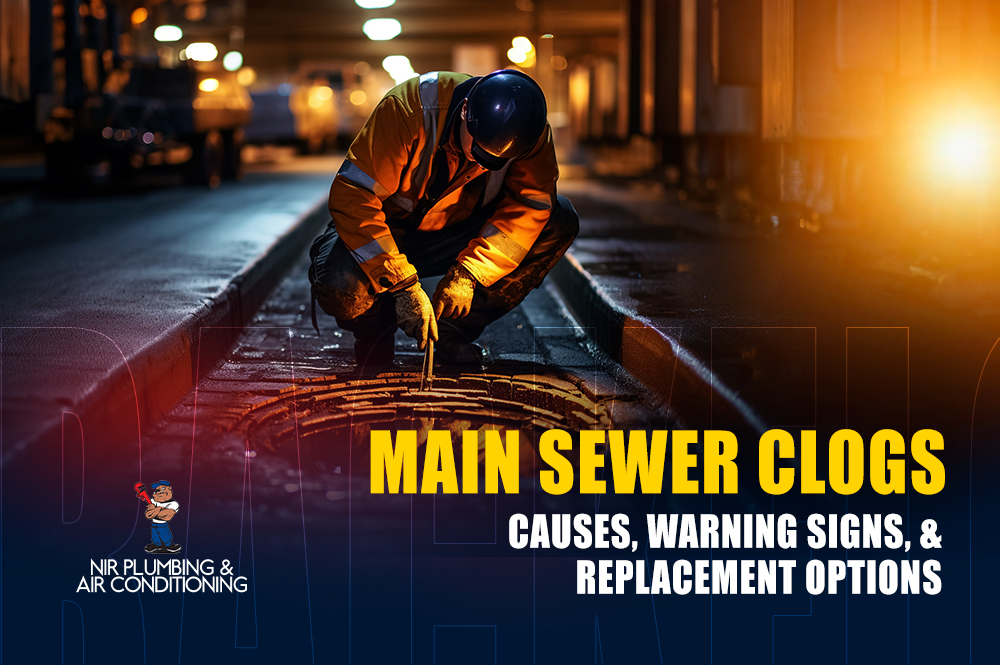Overview: Facing frequent drainage issues? There are multiple common causes, crucial warning signs, and various replacement options for main sewer clogs. Get expert advice on preventing costly repairs and ensuring your plumbing system remains in top condition with this reading!
Imagine this: you’re enjoying a peaceful evening at home when suddenly, you’re faced with water backing up from your drains. This could be a homeowner’s worst nightmare, signaling a problem that nobody wants to deal with — a main sewer clog.
Main sewer clogs are among the most daunting issues homeowners can face, hidden beneath the surface but capable of causing significant disruption and damage. Understanding the causes, recognizing the warning signs, and knowing your replacement options can save you from the unpleasant surprises and costly repairs.
This blog post looks into the murky water of main sewer clogs, equipping you with the knowledge to navigate these challenges.
Let’s get started!
The Underlying Causes
At the heart of most sewer issues are common culprits that hinder the seamless flow of wastewater from your home to the municipal sewer system or your septic tank. These include:
Tree Root Intrusion: Trees, in their quest for moisture, can invade sewer lines, leading to blockages or damage.
>> Here’s What You Should Do About Tree Roots in Your Sewer Line
Grease and Waste Accumulation: The buildup of grease, food particles, and non-flushable items (think “flushable” wipes, feminine hygiene products, and cotton swabs) can lead to significant blockages.
Aging or Collapsed Pipes: Older homes with clay or cast-iron pipes are particularly susceptible to degradation over time, which can cause collapses or severe clogs.
Warning Signs to Watch For
Recognizing the early warning signs of a main sewer clog can be the difference between a manageable repair and a full-blown, messy disaster. Key indicators include:
Multiple Drain Backups: When more than one fixture backs up at the same time, it’s a clear sign that the problem is not localized but rather in the main sewer line.
Water Overflows in Odd Places: Experiencing water backing up in a shower when you flush the toilet, or when running your washing machine, indicates a clog in the main line.
Gurgling Noises: Unusual noises coming from your toilets, drains, or plumbing system can signal a blockage in the sewer line.
Foul Odors: Persistent sewer gas odors in or around your home are a telltale sign of a sewer line issue.
>> Related Reading: 6 Things You Should Never Flush Down the Toilet
Navigating Replacement Options
When faced with a main sewer clog, the severity and nature of the blockage or damage often dictate the best course of action.
Here are replacement and repair options to consider:
Hydro Jetting: For significant blockages without structural pipe damage, hydro jetting can clear the line by blasting high-pressure water through the sewer line.
Pipe Lining: Also known as cured-in-place pipe (CIPP), this method involves creating a new, seamless plastic pipe within the old one, effectively repairing minor damage without excavation.
Pipe Bursting: For more severe damage, pipe bursting replaces the old pipe by pulling a new one through the old pipe’s path while simultaneously fracturing the old pipe outward.
Traditional Excavation: In cases of extreme damage or when the pipes are beyond repair, excavating to replace the sewer line may be the only option. This method is invasive and can be costly but is sometimes necessary.
You might be interested in reading this blog post on Sewer Line Repair and Replacement
Preventive Measures
Prevention is always preferable to repair. Here are some tips to help avoid main sewer clogs:
Be Mindful of What Goes Down the Drain: Avoid flushing anything other than human waste and toilet paper. Be cautious about washing grease and food scraps down the kitchen sink.
Regular Maintenance: Consider annual inspections or cleanings, especially if you have an older home or are located near tree roots prone to invading sewer lines.
Install a Backwater Prevention Valve: This valve allows sewage to go out but not to come back in, offering an added layer of protection against backflow.
In Summary
Main sewer clogs can be a homeowner’s nightmare, but with the right knowledge and preventative measures, you can mitigate the risks and manage the problems effectively. Recognizing the warning signs early and understanding your options can help ensure that your home’s plumbing system remains in good working order, safeguarding your home’s comfort and hygiene.
Whether it’s through proactive maintenance or navigating the murky water of repair and replacement, staying informed is your best defense against the disruptions caused by main sewer clogs.


